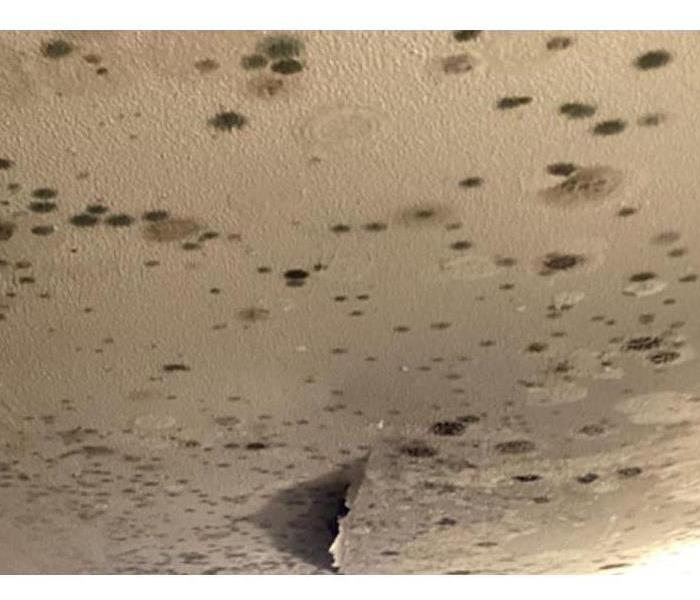Understanding Black Mold
1/23/2024 (Permalink)
What is Black Mold, and Why is it a Concern?
Black mold, scientifically termed Stachybotrys chartarum, is a toxic mold variant that thrives in damp, humid conditions. Often characterized by its dark coloration, this mold is not just an aesthetic concern but poses significant health and structural risks. Its spores, when airborne, can exacerbate respiratory problems, allergies, and even lead to more severe health issues, particularly in those with compromised immune systems. Beyond health risks, black mold can also undermine the structural integrity of buildings, leading to costly repairs and devaluation of property. It is crucial for home and business owners to understand the gravity of black mold infestations and take proactive measures to mitigate its growth and spread.
Primary Causes of Black Mold Growth in Buildings
Understanding the root causes of black mold growth is essential for effective prevention and treatment. Black mold thrives in environments that provide moisture, organic material, and adequate temperatures.
- Moisture: The predominant factor for black mold growth is excess moisture, which can originate from several sources such as leaking pipes, roof leaks, condensation, or high indoor humidity. Buildings with poor drainage systems or those that have experienced flooding are particularly susceptible.
- Poor Ventilation: Inadequate ventilation in buildings leads to moisture accumulation, especially in high-humidity areas like bathrooms and kitchens. This lack of airflow not only supports mold growth but also prevents the drying out of damp areas, further exacerbating the problem.
- Building Materials: Black mold feeds on organic materials found in many building components like wood, drywall, and insulation. These materials, when exposed to moisture, provide the perfect breeding ground for mold.
- Temperature: Mold thrives in warm temperatures, typically found indoors. Buildings with inconsistent temperature regulation or poor insulation can have pockets of warmth that encourage mold growth.
Addressing these key factors is crucial in preventing and managing black mold in any building. By controlling moisture levels, ensuring proper ventilation, and using mold-resistant building materials, the risks associated with black mold can be significantly mitigated.
Identifying Early Signs of Black Mold
Early detection of black mold is crucial in preventing its spread and mitigating potential health risks. Being vigilant about the signs can help in taking timely action. Here are key indicators to watch for:
- Visible Growth: The most obvious sign is the appearance of dark, often black or greenish-black, splotches on surfaces, particularly in moist areas like bathrooms, kitchens, and basements.
- Musty Odors: A persistent musty, earthy smell is a strong indicator of mold presence, even if it's not immediately visible. This odor can be particularly noticeable in closed spaces or upon entering a room.
- Water Damage: Signs of water damage such as water stains, discoloration, or peeling wallpaper/paint can indicate potential mold growth areas, especially if the area remains damp.
- Health Symptoms: Unexplained allergic reactions like sneezing, sore eyes, nasal congestion, or skin irritation when at home may suggest mold presence. People with asthma or respiratory conditions may notice worsening symptoms.
- Humidity and Condensation: Excessive humidity and condensation on windows, pipes, or walls create ideal conditions for mold growth. Regular monitoring of these areas can help in early detection.
Regular inspections, particularly in prone areas, are essential in catching mold growth early. If any signs are detected, it’s advisable to seek professional assessment to determine the extent and necessary remediation steps.
Effective Strategies for Preventing Black Mold Growth
Preventing black mold growth is more manageable than dealing with its aftermath. Implementing effective strategies can significantly reduce the risk of mold infestation in any building. Here are some key preventive measures:
- Control Humidity Levels: Maintain indoor humidity levels between 30-50% using dehumidifiers and air conditioners. This range hinders mold growth.
- Enhance Ventilation: Increase airflow in high-moisture areas like bathrooms and kitchens by using exhaust fans and keeping windows open when possible.
- Immediate Water Damage Response: Address water leaks and spills promptly. The faster you dry the area, the lesser the chance for mold to grow.
- Regular Maintenance Checks: Conduct routine inspections for leaks in roofs, pipes, and walls. Early detection and repair of these issues can prevent mold proliferation.
- Use Mold-Resistant Products: When building or renovating, consider using mold-resistant drywall, paints, and building materials, especially in moisture-prone areas.
- Keep Spaces Clean and Dry: Regular cleaning and vacuuming with HEPA filters can reduce mold spores in the home. Ensure that areas like bathrooms and basements are well-ventilated and dry.
- Proper Insulation: Ensure your home is properly insulated, including windows, doors, and pipes, to reduce the chances of condensation which can lead to mold growth.
Implementing these strategies creates an environment that is not conducive to mold growth, thus safeguarding the structural integrity of the building and the health of its occupants.
Conclusion
Combatting black mold effectively hinges on awareness and proactive prevention. Recognizing the early signs and understanding the causes is vital for maintaining a healthy environment in our homes and businesses. Simple measures like controlling humidity, ensuring good ventilation, and addressing water-related issues promptly can significantly deter mold growth. Regular maintenance and vigilance are key.
Need Expert Mold Remediation? Contact SERVPRO® Today
If you're facing mold challenges in your home or business, don't wait for the problem to escalate. SERVPRO of Greater Hunterdon County's professional mold remediation services are your solution. Our team of experts is equipped with the knowledge, tools, and experience to efficiently identify, address, and prevent mold issues, ensuring your environment is healthy and safe. Trust SERVPRO of Greater Hunterdon County to provide effective, thorough, and timely mold remediation services. Read more about our mold remediation services or give us a call today!

 24/7 Emergency Service
24/7 Emergency Service
